The junction box belongs to the category of electrical distribution products used in the arrangement of wired lines indoors and outdoors. Its functional purpose follows from the name, meaning a device for disconnecting individual conductors. The presence of a removable cover at the box provides maintenance personnel with free access to the internal parts of the wiring if it is necessary to change the switching order. In household networks, this device is used to assemble power buses and their subsequent wiring for specific consumers in an apartment.
Types of junction boxes
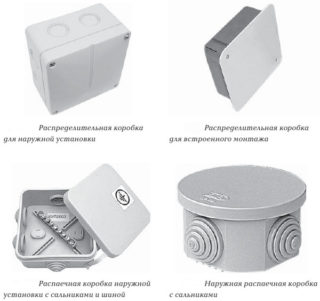
Various samples of junction boxes for electrical wiring are distinguished by the method of installation, as well as by the type of material used in their manufacture and by a number of other characteristics. According to the first of these criteria, they are performed in the following modifications:
- for internal or concealed installation;
- for outdoor installation (overhead boxes).
The first type of installation products is placed in pre-prepared niches drilled in the wall with a special nozzle of the "crown" type. The conductors connected to it are also mounted discreetly in specially prepared strobes. For outdoor installation, the junction box is mounted directly on the wall or on a special plastic socket (plywood blank). For walls finished with plasterboard sheets, a hidden installation method is most often used.
According to the type of material used, all known types of junction boxes for electrical wiring are divided into plastic and steel products. For the manufacture of the second type, tin-plated sheet steel or aluminum alloys that are not subject to corrosion are used. The boxes with the most protected design are provided with hermetically sealed gaskets and a tightly screwed lid.
The metal case guarantees the safety of the conductors placed in it in case of fire for a time sufficient for the protection devices to operate.
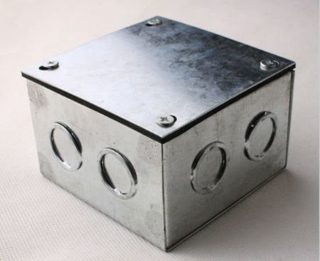
Plastic enclosures for electrical spacers are not as reliable as their metal counterparts. Despite this, they have the following positive qualities:
- oxidation stability;
- good insulating properties (do not conduct electric current);
- lightness and cheapness.
Junction boxes vary in shape and can be square, round or rectangular. The rounded junction box is ideal for lines with few connections and exposed installation. With a large number of cores, it is more convenient to use rectangular plastic or metal products.
If internal installation is required, a round box is considered more convenient, since it is easier to choose a niche in the wall for it.
The geometric dimensions of the wire boxes depend on the total number of conductors and their cross-section.
Benefits of using junction boxes
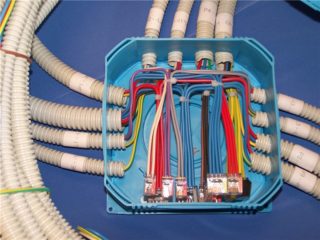
The switch box, correctly selected in type and correctly installed in the chosen location, provides the user with a number of advantages.
- With this approach to the organization of assembly units, the need to search for free conductors to carry out the necessary commutations disappears.
- Knowing where the external electrical distribution boxes are located, it remains only to connect the new device to the existing electrical wiring using their internal wiring.
- Finding a location for hidden installation is also not difficult - for this you will need to examine the section of the wall above the outlet.
- Usually, at a distance of about 3-5 cm from the ceiling, it is possible to find a whitened plastic box lid, which you just need to open.
- Inside, you can create a reliable connection of conductors, guaranteeing high quality switching.
Due to the use of hidden installation of the junction box, its presence does not violate the overall interior of the room. If surface mount is used, the wire harness from the lead set is routed in a decorative cable duct.
Internal structure and switching principle
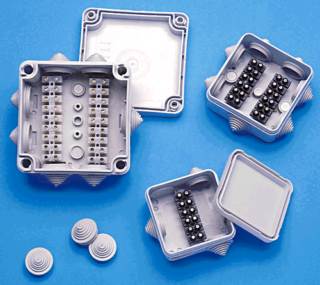
The inner space of a typical box is conventionally divided into 4 zones with adjacent outer walls. Each of them has a perforated hole (usually round) into which cable harnesses are inserted. One of them comes from a switchboard with a linear automaton and includes phase and neutral conductors.
If it is necessary to switch from two adjacent sides, wiring is started from the switches and sockets located in this branch. Upon completion of all the required wiring, the cable cores are looped out towards the adjacent section of the room.
When terminal boxes are installed in dead-end rooms, the number of openings involved may be fewer.
The dimensions of the internal spaces of the distribution device allow placing elements of standard connectors in it.
Methods for connecting wires in a junction box
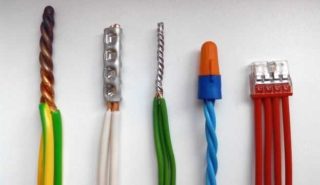
Many options are known for connecting wiring conductors in a junction box. The choice of a particular switching method depends on the material of the supplied conductors (copper or aluminum), the ambient conditions, as well as on the cross-section of the conductors.
Taking into account the above factors, it is allowed to connect the pluggable wires inside the box by the following methods:
- simple twisting followed by soldering of the formed contact;
- by means of special terminal blocks;
- bolted connection;
- self-insulating clamps PPE or "nuts";
- spring terminal blocks of the "Wago" type.
Primitive twisting followed by soldering is used only in cases where conductors of homogeneous materials are connected. Copper and aluminum busbars are not allowed to be combined in this way.
Due to the use of soldering, the twist provides a high quality joint and is usually used when space is limited inside the box due to the impossibility of placing the connecting elements. The advantages of this method include the simplicity and low cost of twisting, and the disadvantages are the complexity of dismantling and the need for an additional tool - an electric soldering iron.
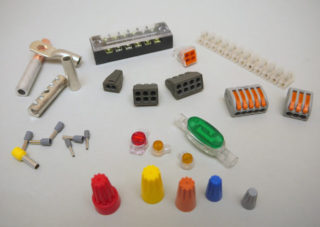
Terminal blocks are ideal for making a reliable connection of wires made of different materials inside a metal junction box, for example. The products used for these purposes are made of plastic and have a brass contact sleeve with screws inside. After inserting the wires from both sides by 5-7 mm, they are securely fixed with a screw clamp. The plastic case provides reliable isolation of the contacts from the metal case of the box.
Bolted connection is a fairly simple but effective way of connecting conductors without direct contact. To equip it, you only need a bolt, three washers and a nut. It is prepared like this:
- A washer is put on the bolt thread, and then the core of one of the conductors, cleaned from the insulating sheath, is screwed on.
- On top of it, another washer is superimposed, onto which the bare end of the second wire is screwed in the same way.
- At the end of the contact, a third washer is applied to the core, and then this entire assembly is clamped with a fastening nut.
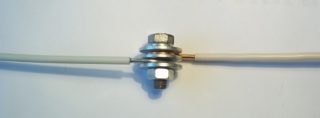
The classic bolted connection is distinguished by the cheapness of fasteners, ease of arrangement of connections, as well as the ability to combine copper and aluminum conductors. The disadvantages include not very high-quality fixation of the ends of dissimilar tires and the need to close the connection with a sheath of insulating material. In addition, it is difficult to fit within the wall box, due to the large size of the bolt used.
Self-insulating contacts are made in the form of a plastic cap, in which a special spring is placed to fix the bare ends of the conductors. The advantages of these connectors include the relatively low cost and the presence of fire-resistant plastic in the structure. The simplicity of the arrangement of the contact connection and the large selection of color shades of the caps are also noted. The disadvantages of PPE include low reliability of fastening, as well as the impossibility of using aluminum and copper conductors to combine.
Wago spring blocks allow you to easily form reliable contact of dissimilar conductors using a special lever clamp. Before using them at the junction with the cores, you will need to remove the insulation. This method has practically no drawbacks, with the exception of the high cost of the terminals themselves.
Features of installation of boxes in hazardous conditions and their designation in the diagrams
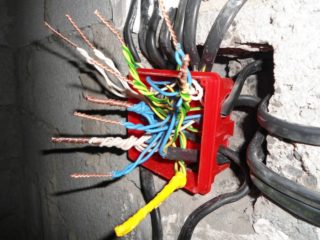
Hazardous conditions for the installation of junction boxes and the arrangement of internal connections include the following situations:
- placement in bathrooms;
- laying of electrical wiring in basement spaces;
- arrangement of a junction box near the ground or in conditions of high humidity (when connecting a submersible pump, for example);
- use for street lighting.
In this case, the conductors are connected only by soldering. It is allowed to twist and tin the formed joint.
The cable entry into the box is sealed very carefully and is most often filled with silicone. The line laid in the ground together with the distribution box is placed in a metal pipe, which excludes the destruction of the product by rodents. In addition, according to the requirements of the PUE, such lines must be grounded. The considered safety measures mainly concern metal junction boxes, in which direct contact with phase voltage threatens the user with an electric shock.
Designation on the diagram
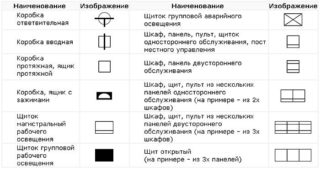
To designate boxes on electrical circuits, special icons are used, usually in the form of a circle or square with straight lines leading to them. By their link to graphic symbols, they are divided into the following categories:
- lead-in boxes;
- branching products;
- straight-through distributors;
- terminal (dead-end) boxes.
Each of the elements indicated by this or that icon performs its function, which is manifested in the difference in their graphic representations (according to GOST 2.755-87).








